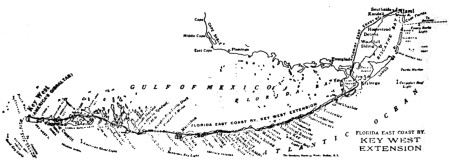Walking the Lines
by Ruby Bryant
Reprinted from "Crown Jewels of the Wire", July 1985, page 12
THE KEY WEST EXTENSION
Recently, while doing some research on Florida telegraph lines, I came across an interesting story. I am most happy to pass it along to our readers.
As we drive to Key West today, few of us realize that a scant 85 years ago this was a major
trip -- made by only the hardier souls.
As late as 1900, the trip to Key West involved a horse back ride to Marathon Key, a ferry to No Name Key, from there a bridge connected you to Big Pine Key, and then you had to go around the islands to Key West.
In the early 1900's Mr. Flagler, one of the founders of the Florida East Coast Railway, decided to put in the Key West Extension. With the completion of this extension, Key West was open to all. The fare from downtown Miami, a distance of 200 miles, to Key West was only $1.00. Overnight and weekends trips were somewhat higher.
On Labor Day weekend of September, 1935, advertisements in the Miami Daily News and on placards around the city proclaimed a "Big Four Dollar Key Tour". The trip was scheduled to leave Miami early Saturday, August 31, and arrive at Key West in the late afternoon. It was to leave Key West Monday afternoon arriving back in Miami late that night. Hundreds of people took this late opportunity of the summer season for one last fling.
The train puffed out of Miami on time and arrived in Key West, where it discharged it's passengers for a weekend of fishing and sun bathing. No one took much note of a tropical storm forming east of the Bahaman Islands.
It was not until Sunday, September 1, that the storm began to merit serious attention. It was decided that it was not practical to collect the passengers and leave early.

Near departure time on Monday the square red and black hurricane flags were hoisted over the Keys. These red and black harbingers of danger finally alerted the authorities. No one would dare send out a train, in fear of the approaching hurricane.
Late Monday afternoon the hurricane roared across the upper and middle Key's. Hundreds of people perished by drowning. The railroad was demolished for miles. Telephone and telegraph lines, attached to the railway bridges, went into the water as the bridges gave way to the on rushing water. All communication was lost.
Casualties in Key West were few, since the highest winds were north of there. But what of the train load of visitors? No railroad existed, any longer. The highway, dependent upon two ferries to get over the deep water could not be used as both ferries were out of service. However, none of this was known in Key West.
Key West did not receive the center of the storm. About 10:00 PM Monday the wind at Key West had begun to subside. The passengers were boarded and the train began to inch its way up the Keys, still harassed by gale force winds. Neither the railroad officials nor the train crew was aware of the conditions of the road beds or the tracks. It was nearly daylight before the truth began to appear. When the train arrived at Snake Creek, well up into the keys, but still a long way from home, the tracks were completely washed away.
Needless to say, the vendors on the train sold out their entire stock of snacks and sandwiches. The passengers accepted the emergency situation in good humor, leaving the train on foot to forage for food.
After a good deal of searching, they found a small grocery store with the proprietor and some stock intact. What beverage he had was soon sold out.
Finally, Tuesday afternoon a decision was reached that a return to Key West was the only
possibility -- having to back the train all the way. The weary passengers returned to their lodgings, including the legendary La Concha Hotel, early Wednesday morning.
About 5:00 PM Wednesday the Peninsular & Occidental's S.S. Cuba put into Key West, for a brief layover enroot to Havana. From Havana it was to sail to Tampa.
Although the ship was loaded with other excursionist's, she agreed to take the stranded railroad passengers, most of them as deck passengers. The attendants on the S.S. Cuba did their best to accommodate their super-cargo. One spirited young lady, remembered by several aboard the train as the "Lady in Red", succumbed to the excitement and the still rough Gulf of Mexico, became ill enough to need bed rest. An official of the steamship line surrendered his stateroom, allowing the girl to rest in his berth during the overnight trip to Tampa. Other passengers fared but little better. Dining room stewards passed among the travelers offering food, but finding few takers.
Thursday morning, five days after they had left Miami, the railroad passengers arrived in Tampa where a special train had been ordered to return them to Miami.
For those who took that ill-fated trip they will never forget "The Last Train to Key West". For to this day, they have never rebuilt that railroad line.
What happened to the insulators from that line? Most went into the water during the storm. A skin diver found some Hemingray 43 cables in blue; also, some Hemingray 40's and 42's with one inch drip points, which were very pretty. Other insulators have been found with white coral all around them, which display very nicely in your collection. Most are still lying under the water and sand waiting for the collector to discover them.
I had the pleasure of getting some Whitall Tatum 1's in purple when they took the remaining sections of the line down about 30 years ago. They are a very dark purple and very pretty.
| 